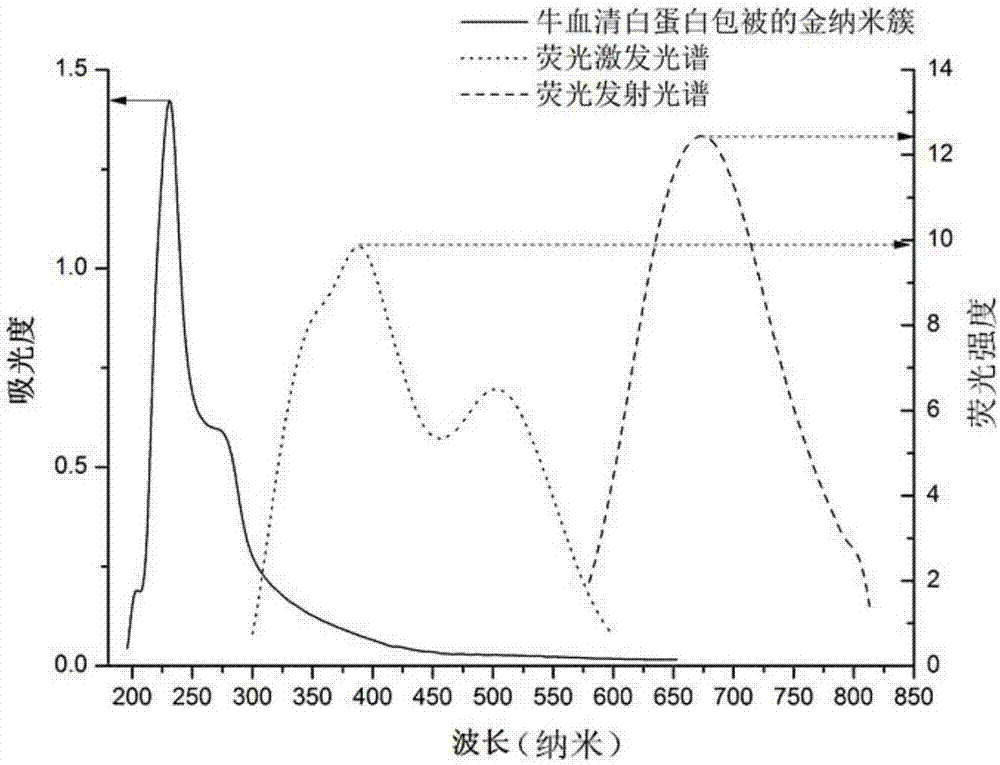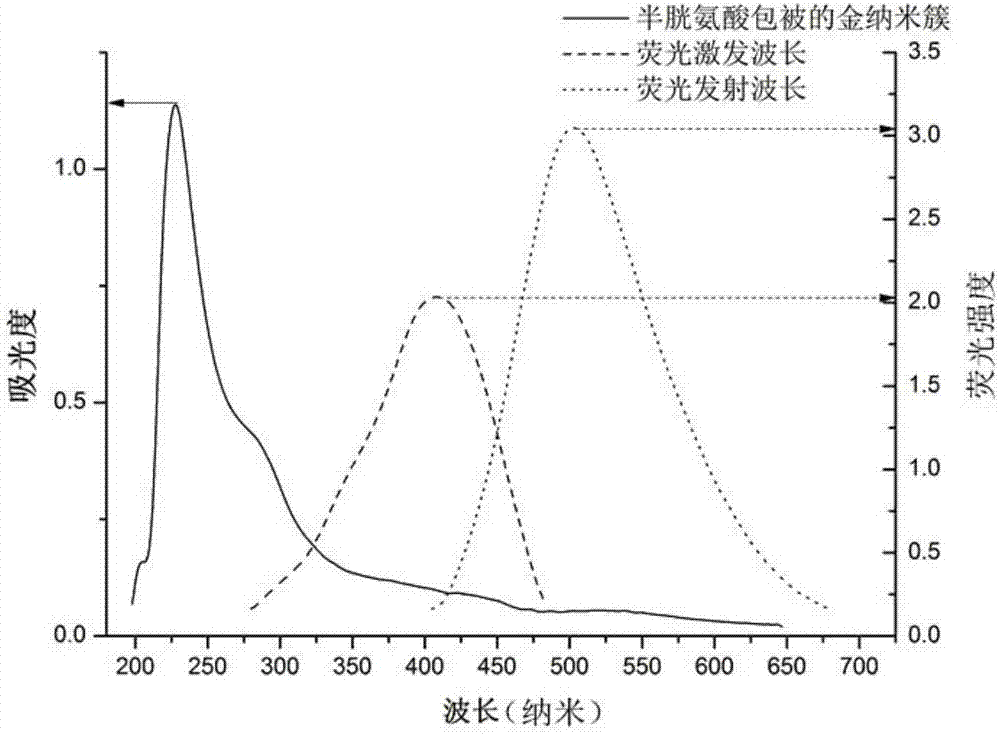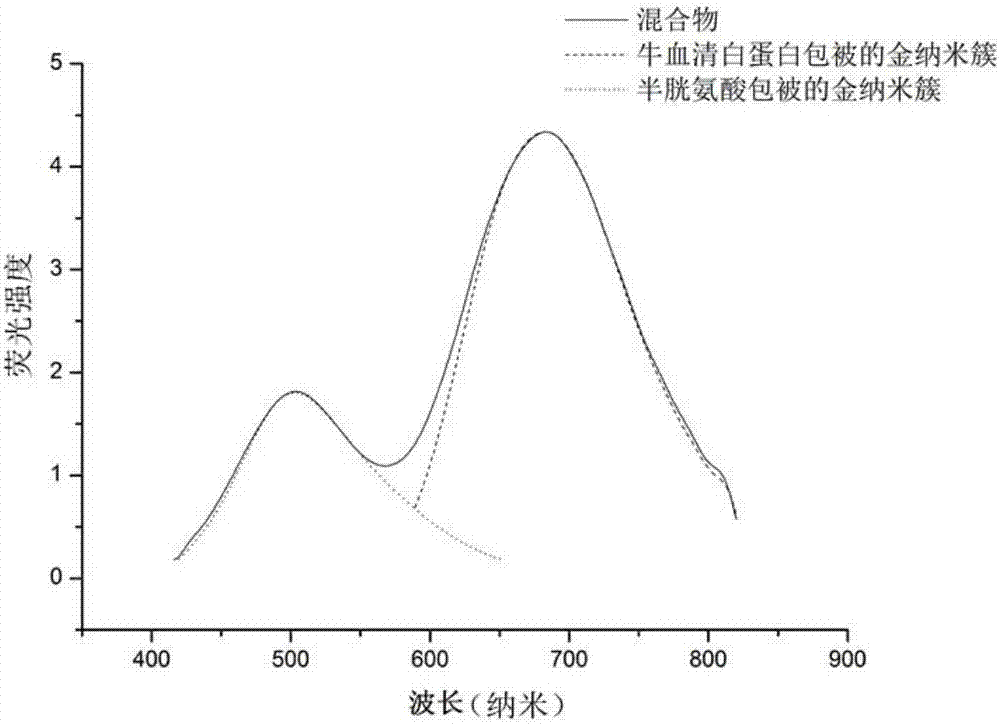Method for selective sensitive mercury ion detection based on gold nano-cluster fluorescence ratio detection test strip
A gold nanocluster and detection test paper technology, applied in the field of nanomaterials, can solve problems such as time-consuming, inability to know the content of metal ions, and inability to store for a long time.
- Summary
- Abstract
- Description
- Claims
- Application Information
AI Technical Summary
Problems solved by technology
Method used
Image
Examples
Embodiment 1
[0021] Example 1: Preparation of BSA-Au NCs
[0022] The glass instruments and magnetic stirrer required for the experiment were soaked in aqua regia for more than 12 hours, cleaned with ultrapure water, and dried in the air for later use. Place 5mL of BSA solution (50mg / mL) at 37°C and stir vigorously, then quickly add 5mL of chloroauric acid solution (10mmol / L), and mix evenly under uniform stirring conditions. At this time, the solution is bright yellow; then add 0.5mL 1mol / L sodium hydroxide solution, the pH value of the solution is about 11, and the color of the solution is orange. Continue to stir the mixed solution in a water bath at 37°C for 12 hours, and then the color turns dark orange, and a stable Au nanoclusters, the pH of the solution is about 9 at this time. Afterwards, the sample was dried, redissolved in ultrapure water, and the solution was adjusted to pH = 9. The prepared BSA-Au NCs solution was stored at 4°C for future use. Its UV-Vis absorption spectrum,...
Embodiment 2
[0023] Example 2: Preparation of Cys-Au NCs
[0024] First, the preparation of gold nanoparticles (Au NPs) was carried out. At room temperature, add 0.25mL of 1mol / L sodium hydroxide solution to 21.02mL of ultrapure water, and then add 0.5mL of tetrakishydroxymethyl phosphorus chloride solution (the solution is diluted to 0.5mL of ultrapure prepared in water), the solution was stirred vigorously at room temperature for 5 minutes, and then 2.23mL of chloroauric acid solution (10mM) was added quickly, the solution turned dark brown, and the stirring was continued at a constant speed for 25 minutes to finally obtain a dark brown gold nanoparticle solution , stored at 4°C for later use.
[0025] Second, the preparation of Cys-Au NCs was carried out. We prepared the desired nanoclusters by chemical etching synthesis. Add 1mL of cysteine solution (0.0138g / mL) into 10mL of gold nanoparticle solution, stir vigorously, then quickly add 30μL of 1mol / L sodium hydroxide solution, and...
Embodiment 3
[0026] Embodiment 3: the preparation of the mercury ion sensor of fluorescent ratio probe
[0027]Take 40 μL of BSA-Au NCs solution and 260 μL of Cys-Au NCs solution and put them in 700 μL of 0.1 mol / L PBS solution with pH=8.0 (mix 0.1 mol / L potassium dihydrogen phosphate solution and 0.1 mol / L dipotassium hydrogen phosphate solution according to 1:19 volume ratio mixed), and stirred thoroughly for 1 minute to obtain a fluorescence ratio probe with dual fluorescence emission. At this time, the concentration of BSA-Au NCs and Cys-Au NCs in the solution was about 200 μM, and the concentrations were both in the precursor Body concentration calculations. The fluorescence emission spectra of BSA-Au NCs solution, Cys-Au NCs solution and the mercury ion sensor of the fluorescent ratio probe and the solution color under visible light and 365nm ultraviolet light are as follows: image 3 shown.
PUM
| Property | Measurement | Unit |
|---|---|---|
| concentration | aaaaa | aaaaa |
| concentration | aaaaa | aaaaa |
Abstract
Description
Claims
Application Information
 Login to View More
Login to View More - R&D
- Intellectual Property
- Life Sciences
- Materials
- Tech Scout
- Unparalleled Data Quality
- Higher Quality Content
- 60% Fewer Hallucinations
Browse by: Latest US Patents, China's latest patents, Technical Efficacy Thesaurus, Application Domain, Technology Topic, Popular Technical Reports.
© 2025 PatSnap. All rights reserved.Legal|Privacy policy|Modern Slavery Act Transparency Statement|Sitemap|About US| Contact US: help@patsnap.com



